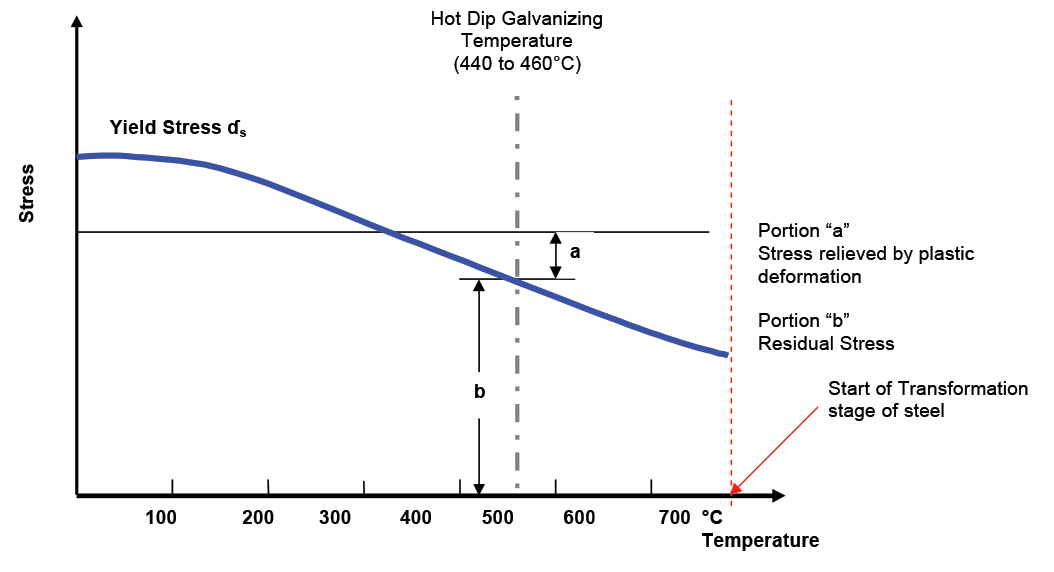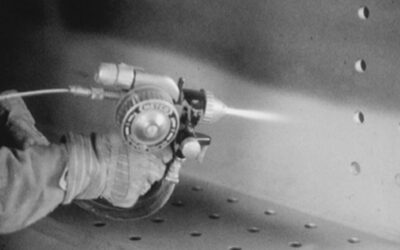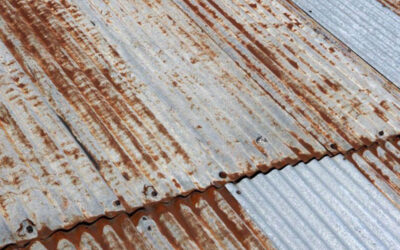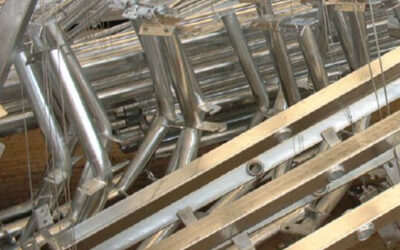Causes
When steel components are heated to the hot dip galvanizing temperature of approximately 450C, internal stresses can be released resulting in distortion. At this temperature, the limit of elasticity and the value of Young’s Modulus of the steel are reduced to about half the value of that at room temperature.
When very high internal stresses are generated in a steel structure, it is possible that the highest levels of stresses that are above the elasticity of the steel (which are reduced at the hot dip galvanizing temperature) then the steel may no longer accommodate these internal stresses. Such stresses are released as plastic deformation and distortion results. (Fig. 1).

Fig 1 Schematic view of the yield limit of the steel changed by the increase in temperature
showing stresses which can result in distortion.
Limited internal stresses are normally present in most steel structures and generally do not result in distortion after hot dip galvanizing.
Internal stresses are usually caused by combinations of the following:
- Residual stresses induced at the steel mill during rolling of structural sections or plate.
- Residual stresses created by bending or welding during fabrication.
- Lack of symmetrical sections such as fabricated sections.
- Combination of thick and significantly thinner materials, within the same assembly, resulting in differential expansion and contraction leading to distortion.
- Large assemblies that require double end or side dipping to successfully coat the entire surface. (Skilled galvanizers are able to successfully double dip components.)
Internal stresses are normally in equilibrium with each other and will not result in distortion, however, due to the reasons identified above, it is difficult to accurately predict whether distortion will occur or not.
When fabricating complex structures, it is normally impossible to avoid the introduction of some internal stresses. It is said that internal stresses, due to welding, have the highest potential to create distortion during the hot dip galvanizing process.
Preventing Distortion
Steps are taken during the hot dip galvanizing process to minimize the distortion within a steel structure, but consideration must be also be given to which internal stresses can be incurred during design, fabrication and specifically the welding procedures.
Internal stresses developed during welding can result in post hot dip galvanizing distortion. Welding controls, from the outset of the fabrication process, should be to minimise stresses in a structure so that the steel is able to withstand the internal stresses despite its reduction in elasticity during the galvanizing process.
The main requirements for reducing potential distortion are uniform and symmetrical cross
sections, symmetrical arrangements of the welding seams and, where practical, restricting the size of welding seams to a minimum.
Consider the Following Aspects during Fabrication
Products Shaped by Bending
During hot dip galvanizing a plate rolled to form part of a circular structure may release certain stresses, causing the radius of the component to increase, resulting in assembly difficulties when constructing the final structure. These difficulties are overcome by installing temporary braces across the section to ensure that the object retains its desired shape. Braces can be either welded or bolted in position, with size and thickness proportional to the plate being retained.
Braces should be located at quarter points along the length of the structure. Similar results can be obtained with bent troughs, angle frames, cylinders and back to back channels. It will, however, be necessary to touch up the area where the braces have been removed, with an approved coating repair material.
Welding and Fabrication Induced Stresses
Welding plays an essential part in fabricated components that are to be hot dip galvanized. It is important to address how welding stresses are generated and to minimise them during fabrication.
Following a few basic rules, control and reduction of distortion is possible.
- Avoid over welding, welds should be no larger than is essential for the structural integrity of the fabrication.
- Welding should be as symmetrical as possible, in order to balance internal stresses. This can be achieved by locating welding near or by balancing them around the neutral axis.
- Plan and follow a balanced welding sequence. When fabricating large structures, exercise care to minimise stresses by preparing and working to a welding plan.
- Weld seams that significantly reinforce structural strength should, as far as possible, be welded last so as not hinder the contraction of other welds.
- Fewer weld passes reduce the welding time and limit heat input.
- Use opposing weld shrinkage forces to balance each other.
- Use backstop welding or staggered welding to minimise welding stresses.
Should a fabrication distort, either, during or after welding, such distortion tends be accentuated after hot dip galvanizing. It is possible to straighten such items, but the best results are obtained by hot straightening before hot dip galvanizing. Tests indicate that hot straightened components to within tolerances, before hot dip galvanizing, will not distort after hot dip galvanizing.
Non-symmetrical Fabricated Components
Fabricated components, substantially symmetrical in both the horizontal and vertical planes, have a far lower potential to distort during hot dip galvanizing. Symmetrical components induce thermal expansion forces that are balanced and hence less prone to suffer distortion. Such conditions exists in tubes, I-beams, square and rectangular hollow sections and other similar sections. Symmetrical sections used in complex fabrications, may lose symmetry and result in distortion. Consider a length of thin walled rectangular hollow section welded to the top of an I-beam. The resultant geometric shape of the fabricated component is no longer symmetrical. The thinner walled tubing will reach the galvanizing temperature far sooner than the thicker I-beam, resulting in differential expansion and contraction and a tendency to bow the beam.
Sections, which are asymmetrical, such as channels and angles will experience similar problems due to their in-built asymmetry. In the case of channels, the section will bow with the toes pointing outwards.
Consider the following three recommendations to control the potential for bowing.
- Design the fabrication as symmetrical as possible.
- Fabricate and hot dip galvanize the components as individual components, and bolts or weld assembly after galvanizing. Welding is repaired following approved procedures.
- Using bolts and pipe spacers to separate, assemble two asymmetrical pieces back to back. Hot dip galvanize and then separate after cooling, all contact surfaces can now be touched up using an approved repair material.
Combining Thick and Thin Material within an Assembly
Thin material heated during hot dip galvanizing, expands at a faster rate than that of thicker material. Thinner material is prone to distort should the thicker section restrict its expansion. A large fabricated (welded) plate girder, comprising a relatively thin web, with substantially thicker restrained flanges, could result in differential expansion and contraction of the component parts, leading to potential distortion of the web.
Two methods are used to control such potential distortion.
- Provide symmetrical stiffening ribs to control the expansion and contraction.
- Provide a controlled, uniform cooling rate.Use a similar frame and sheet material thickness.
Hot Dip Galvanizing Oversized Objects
Fabricated components, too large for a single immersion in molten zinc, double end dipping or side dipping can be employed. This process increases the potential for distortion as it introduces differential heating of the component. One end is heated to the galvanizing temperature and will expand, while the opposite end remains at ambient temperature. Rotating the component for the second immersion will not remove potential distortion and may result in the section bowing. Should double end dipping of components susceptible to distortion be unavoidable, consult the Association for specific additional procedures.
Bowing distortion can be restricted by the following controls.
- Designing the components in modular lengths to suit a bath size so that a single immersion can be achieved.
- Do not quench the section after hot dip galvanizing, but allow to air cool while positioned on a flat horizontal surface.
- Allowing for linear expansion in the design so that any distortion is plastic and is not constrained by any cross bracing.
Distortion as a result of double end dipping is rarely seen in simple pipes and poles due to their symmetry.
Long Thin Objects
Generally, long thin poles and pipes will not necessary distort due to their symmetrical design. Should they be lifted at both ends, however, they may take on a characteristically bowed shape following the hot dip galvanizing process. Distortion is aggravated if fill and drain holes are insufficient in size, allowing the object to retain molten zinc when being lifted from the galvanizing bath.
Bowing of this nature becomes permanent when the steel cools.
Two methods are suggested to control distortion arising from the above:
- Lifting lugs or holes should be provided at quarter points.
- Vent and drain holes should be located and sized to maximise the rate of drainage and
minimise the retention of molten zinc within the section.
Note: Ensuring that vent, filling and drain holes in hollow sections are sized correctly to enable rapid filling and drainage of cleaning liquids and molten zinc.




